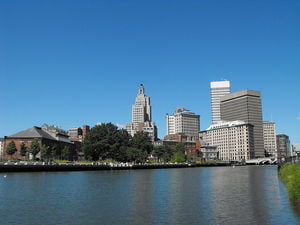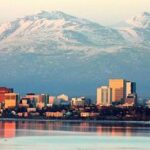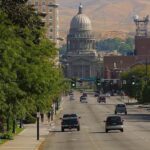This article, the thirty-ninth in a 50-state series, lists the twenty largest cities in Rhode Island by population size and provides demographic details for each city: total population, population by age group, racial composition of the population, land area, and population density. For purposes of this article, cities are incorporated municipalities and census-designated places (CDPs).
After reading “Largest Cities in Rhode Island (2011),” return to this link to read “Best Places to Live in Rhode Island (2011) .”
Similar articles for the remaining 49 states can be found at these links: Alabama, Alaska, Arizona, Arkansas, California, Colorado, Connecticut, Delaware, Florida, Georgia, Hawaii, Idaho, Illinois, Indiana, Iowa, Kansas, Kentucky, Louisiana, Maine, Maryland, Massachusetts, Michigan, Minnesota, Mississippi, Missouri, Montana, Nebraska, Nevada, New Hampshire, New Jersey, New Mexico, New York, North Carolina, North Dakota, Ohio, Oklahoma, Oregon, Pennsylvania, South Carolina, South Dakota, Tennessee, Texas, Utah, Vermont, Virginia, Washington, West Virginia, Wisconsin, and Wyoming.
1. Largest Cities in Rhode Island (2011): Providence, RI
Located in eastern Rhode Island, Providence is the state’s capital and largest city with an estimated population of 178,042.
A comparatively large percentage of the population is college-aged: the city is home to a number of colleges and universities including Brown University and Providence College. Grouped by age, 23.4% of the population is under 18, 20.3% is 18 to 24, 28.3% is 25 to 44, 19.3% is 45 to 64, and 8.7% is 65 or older. The median age of the population is 28.5.
The racial composition of the city is 49.8% White, 16.0% Black or African American, 1.4% Native American, 6.4% Asian, 0.1% Pacific Islander, 19.8% from other races, and 6.5% from two or more races. The population is 38.1% Hispanic or Latino of any race.
The land area of the city is 18.5 square miles. The city’s population density is 9,624 people per square mile.
2. Largest Cities in Rhode Island (2011): Warwick, RI
Situated in central Rhode Island, Warwick is the second largest city in the state with an estimated population of 82,672.
Classified by age, 19.1% of the population is under 18, 7.9% is 18 to 24, 25.2% is 25 to 44, 30.8% is 45 to 64, and 17.0% is 65 or older. The median age of the population is 43.7.
The racial complexion of the city is 92.7% White, 1.7% Black or African American, 0.3% Native American, 2.3% Asian, 1.1% from other races, and 1.9% from two or more races. The population is 3.4% Hispanic or Latino of any race.
The land area of the city is 35.5 square miles. The city’s population density is 2,329 people per square mile.
3. Largest Cities in Rhode Island (2011): Cranston, RI
Located in central Rhode Island, Cranston is the third largest city in the state with an estimated population of 80,387.
Categorized by age, 20.4% of the population is under 18, 9.2% is 18 to 24, 26.6% is 25 to 44, 28.5% is 45 to 64, and 15.3% is 65 or older. The median age of the population is 40.8.
The racial profile of the city is 81.9% White, 5.3% Black or African American, 0.3% Native American, 5.2% Asian, 0.1% Pacific Islander, 4.6% from other races, and 2.7% from two or more races. The population is 10.8% Hispanic or Latino of any race.
The land area of the city is 28.6 square miles. The city’s population density is 2,811 people per square mile.
4. Largest Cities in Rhode Island (2011): Pawtucket, RI
Situated in northeastern Rhode Island, Pawtucket is the fourth largest city in the state with an estimated population of 71,148.
Sorted by age, 23.3% of the population is under 18, 9.9% is 18 to 24, 28.5% is 25 to 44, 25.7% is 45 to 64, and 12.6% is 65 or older. The median age of the population is 36.7.
The racial makeup of the city is 66.5% White, 13.4% Black or African American, 0.6% Native American, 1.5% Asian, 0.1% Pacific Islander, 11.8% from other races, and 6.1% from two or more races. The population is 19.7% Hispanic or Latino of any race.
The land area of the city is 8.7 square miles. The city’s population density is 8,178 people per square mile.
5. Largest Cities in Rhode Island (2011): East Providence, RI
Located in eastern Rhode Island, East Providence is the fifth largest city in the state with an estimated population of 47,037.
Arranged by age, 19.5% of the population is under 18, 7.9% is 18 to 24, 25.9% is 25 to 44, 28.4% is 45 to 64, and 18.3% is 65 or older. The median age of the population is 42.6.
The racial mix of the city is 84.0% White, 5.8% Black or African American, 0.5% Native American, 1.5% Asian, 3.9% from other races, and 4.2% from two or more races. The population is 4.1% Hispanic or Latino of any race.
The land area of the city is 13.4 square miles. The city’s population density is 3,510 people per square mile.
6. Largest Cities in Rhode Island (2011): Woonsocket, RI
Located in northern Rhode Island, Woonsocket is the sixth largest city in the state with an estimated population of 41,186.
Grouped by age, 24.0% of the population is under 18, 9.4% is 18 to 24, 27.6% is 25 to 44, 25.9% is 45 to 64, and 13.1% is 65 or older. The median age of the population is 36.8.
The racial composition of the city is 77.7% White, 6.4% Black or African American, 0.4% Native American, 5.4% Asian, 5.7% from other races, and 4.3% from two or more races. The population is 14.2% Hispanic or Latino of any race.
The land area of the city is 7.7 square miles. The city’s population density is 5,348 people per square mile.
7. Largest Cities in Rhode Island (2011): Newport, RI
Situated in southeastern Rhode Island, Newport is the seventh largest city in the state with an estimated population of 24,672.
Classified by age, 16.5% of the population is under 18, 16.2% is 18 to 24, 28.1% is 25 to 44, 24.9% is 45 to 64, and 14.3% is 65 or older. The median age of the population is 36.4.
The racial complexion of the city is 82.5% White, 6.9% Black or African American, 0.8% Native American, 1.4% Asian, 0.1% Pacific Islander, 3.1% from other races, and 5.2% from two or more races. The population is 8.4% Hispanic or Latino of any race.
The land area of the city is 7.9 square miles. The city’s population density is 3,123 people per square mile.
8. Largest Cities in Rhode Island (2011): Central Falls, RI
Located in northeastern Rhode Island, Central Falls is the eighth largest city in the state with an estimated population of 19,376.
Categorized by age, 29.1% of the population is under 18, 12.0% is 18 to 24, 30.9% is 25 to 44, 19.4% is 45 to 64, and 8.6% is 65 or older. The median age of the population is 30.1.
The racial profile of the city is 52.9% White, 10.1% Black or African American, 0.9% Native American, 0.6% Asian, 0.1% Pacific Islander, 28.7% from other races, and 6.6% from two or more races. The population is 60.3% Hispanic or Latino of any race.
The land area of the city is 1.2 square miles. The city’s population density is 16,147 people per square mile.
9. Largest Cities in Rhode Island (2011): Westerly, RI
Situated in southwestern Rhode Island, Westerly is the ninth largest city in the state with an estimated population of 17,936.
Sorted by age, 21.1% of the population is under 18, 6.8% is 18 to 24, 23.9% is 25 to 44, 29.7% is 45 to 64, and 18.5% is 65 or older. The median age of the population is 43.6.
The racial makeup of the city is 92.2% White, 1.0% Black or African American, 0.5% Native American, 3.0% Asian, 1.0% from other races, and 2.2% from two or more races. The population is 3.2% Hispanic or Latino of any race.
The land area of the city is 30.1 square miles. The city’s population density is 896 people per square mile.
10. Largest Cities in Rhode Island (2011): Newport East, RI
Located in southeastern Rhode Island, Newport East is the tenth largest city in the state with an estimated population of 11,769.
Arranged by age, 20.1% of the population is under 18, 7.3% is 18 to 24, 23.7% is 25 to 44, 29.8% is 45 to 64, and 19.1% is 65 or older. The median age of the population is 44.1.
The racial mix of the city is 86.3% White, 5.0% Black or African American, 0.4% Native American, 3.0% Asian, 0.2% Pacific Islander, 1.6% from other races, and 3.5% from two or more races. The population is 4.8% Hispanic or Latino of any race.
The land area of the city is 7.9 square miles. The city’s population density is 1,490 people per square mile.
11. Largest Cities in Rhode Island (2011): Valley Falls, RI
Located in northeastern Rhode Island, Valley Falls is the eleventh largest city in the state with an estimated population of 11,547.
Grouped by age, 21.4% of the population is under 18, 7.6% is 18 to 24, 25.6% is 25 to 44, 29.8% is 45 to 64, and 15.6% is 65 or older. The median age of the population is 41.9.
The racial composition of the city is 91.7% White, 1.9% Black or African American, 0.6% Native American, 0.9% Asian, 2.7% from other races, and 2.3% from two or more races. The population is 7.9% Hispanic or Latino of any race.
The land area of the city is 3.5 square miles. The city’s population density is 3,299 people per square mile.
12. Largest Cities in Rhode Island (2011): Greenville, RI
Situated in northern Rhode Island, Greenville is the twelfth largest city in the state with an estimated population of 8,658.
Classified by age, 19.1% of the population is under 18, 6.7% is 18 to 24, 19.9% is 25 to 44, 31.4% is 45 to 64, and 22.9% is 65 or older. The median age of the population is 47.6.
The racial complexion of the city is 97.1% White, 0.8% Black or African American, 0.1% Native American, 0.9% Asian, 0.4% from other races, and 0.7% from two or more races. The population is 1.4% Hispanic or Latino of any race.
The land area of the city is 5.2 square miles. The city’s population density is 1,665 people per square mile.
13. Largest Cities in Rhode Island (2011): Wakefield-Peacedale, RI
Located in southern Rhode Island, Wakefield-Peacedale is the thirteenth largest city in the state with an estimated population of 8,487.
Categorized by age, 23.5% of the population is under 18, 8.1% is 18 to 24, 22.8% is 25 to 44, 31.1% is 45 to 64, and 14.5% is 65 or older. The median age of the population is 41.6.
The racial profile of the city is 90.3% White, 1.8% Black or African American, 2.6% Native American, 1.4% Asian, 0.7% from other races, and 3.2% from two or more races. The population is 2.5% Hispanic or Latino of any race.
The land area of the city is 4.9 square miles. The city’s population density is 1,732 people per square mile.
14. Largest Cities in Rhode Island (2011): Cumberland Hill, RI
Situated in northeastern Rhode Island, Cumberland Hill is the fourteenth largest city in the state with an estimated population of 7,934.
Sorted by age, 23.2% of the population is under 18, 5.9% is 18 to 24, 27.0% is 25 to 44, 29.0% is 45 to 64, and 14.9% is 65 or older. The median age of the population is 41.3.
The racial makeup of the city is 93.6% White, 1.2% Black or African American, 0.1% Native American, 2.9% Asian, 0.8% from other races, and 1.3% from two or more races. The population is 2.6% Hispanic or Latino of any race.
The land area of the city is 3.3 square miles. The city’s population density is 2,404 people per square mile.
15. Largest Cities in Rhode Island (2011): Tiverton, RI
Located in southeastern Rhode Island, Tiverton is the fifteenth largest city in the state with an estimated population of 7,557.
Arranged by age, 19.0% of the population is under 18, 5.8% is 18 to 24, 24.3% is 25 to 44, 30.7% is 45 to 64, and 20.2% is 65 or older. The median age of the population is 45.6.
The racial mix of the city is 95.7% White, 1.2% Black or African American, 0.1% Native American, 1.0% Asian, 0.3% from other races, and 1.6% from two or more races. The population is 1.7% Hispanic or Latino of any race.
The land area of the city is 29.4 square miles. The city’s population density is 257 people per square mile.
16. Largest Cities in Rhode Island (2011): Kingston, RI
Located in southeastern Rhode Island, Kingston is the sixteenth largest city in the state with an estimated population of 6,974.
Grouped by age, 5.5% of the population is under 18, 78.4% is 18 to 24, 6.0% is 25 to 44, 6.5% is 45 to 64, and 3.6% is 65 or older. The median age of the population is 19.8.
The racial composition of the city is 85.3% White, 5.7% Black or African American, 0.4% Native American, 4.0% Asian, 0.1% Pacific Islander, 2.2% from other races, and 2.3% from two or more races. The population is 6.2% Hispanic or Latino of any race.
The land area of the city is 1.57 square miles. The city’s population density is 4,442 people per square mile.
17. Largest Cities in Rhode Island (2011): Pascoag, RI
Situated in northern Rhode Island, Pascoag is the seventeeth largest city in the state with an estimated population of 4,577.
Classified by age, 22.6% of the population is under 18, 7.9% is 18 to 24, 24.8% is 25 to 44, 30.8% is 45 to 64, and 14.3% is 65 or older. The median age of the population is 41.2.
The racial complexion of the city is 96.4% White, 0.7% Black or African American, 0.4% Native American, 0.2% Asian, 0.8% from other races, and 1.5% from two or more races. The population is 2.6% Hispanic or Latino of any race.
The land area of the city is 5.0 square miles. The city’s population density is 915 people per square mile.
18. Largest Cities in Rhode Island (2011): Narragansett Pier, RI
Located in southeastern Rhode Island, Narragansett Pier is the eighteenth largest city in the state with an estimated population of 3,409.
Categorized by age, 11.9% of the population is under 18, 19.8% is 18 to 24, 16.7% is 25 to 44, 29.1% is 45 to 64, and 22.5% is 65 or older. The median age of the population is 46.1.
The racial profile of the city is 95.1% White, 1.2% Black or African American, 1.3% Native American, 1.0% Asian, 0.1% Pacific Islander, 0.4% from other races, and 0.9% from two or more races. The population is 1.5% Hispanic or Latino of any race.
The land area of the city is 3.6 square miles. The city’s population density is 947 people per square mile.
19. Largest Cities in Rhode Island (2011): Chepachet, RI
Situated in northwestern Rhode Island, Chepachet is the nineteenth largest city in the state with an estimated population of 1,675.
Sorted by age, 21.0% of the population is under 18, 7.7% is 18 to 24, 21.9% is 25 to 44, 35.1% is 45 to 64, and 14.3% is 65 or older. The median age of the population is 44.6.
The racial makeup of the city is 97.0% White, 0.1% Black or African American, 0.1% Native American, 0.8% Asian, 0.7% from other races, and 1.3% from two or more races. The population is 1.7% Hispanic or Latino of any race.
The land area and population density of the city are not available.
20. Largest Cities in Rhode Island (2011): Hope Valley, RI
Located in southern Rhode Island, Hope Valley is the twentieth largest city in the state with an estimated population of 1,612.
Arranged by age, 24.4% of the population is under 18, 6.9% is 18 to 24, 24.2% is 25 to 44, 32.7% is 45 to 64, and 11.8% is 65 or older. The median age of the population is 41.7.
The racial mix of the city is 97.1% White, 0.2% Black or African American, 0.6% Native American, 0.1% Asian, 0.1% from other races, and 1.9% from two or more races. The population is 1.2% Hispanic or Latino of any race.
The land area of the city is 3.3 square miles. The city’s population density is 488 people per square mile.
Source(s):
“American Fact Finder,” U.S. Census Bureau
“Population, Housing Units, Area, and Density: 2000,” U.S. Census Bureau









